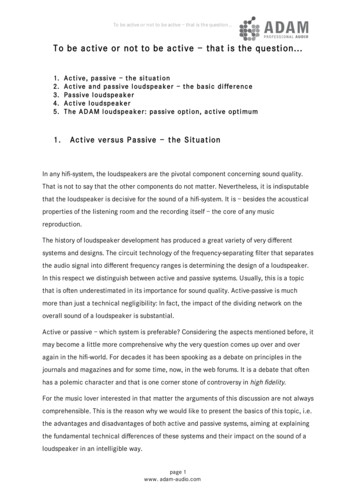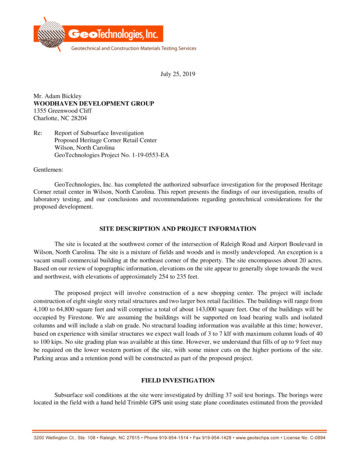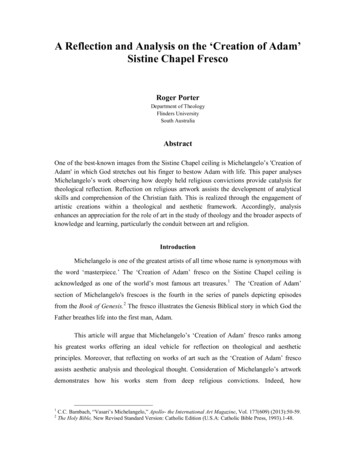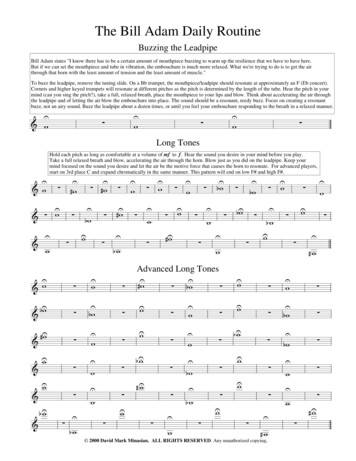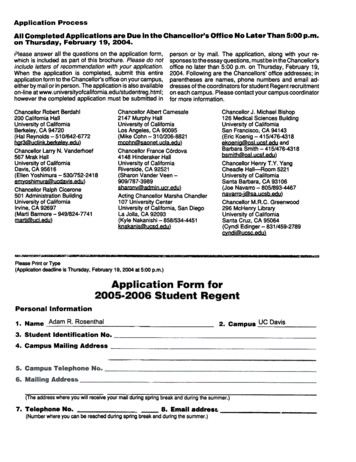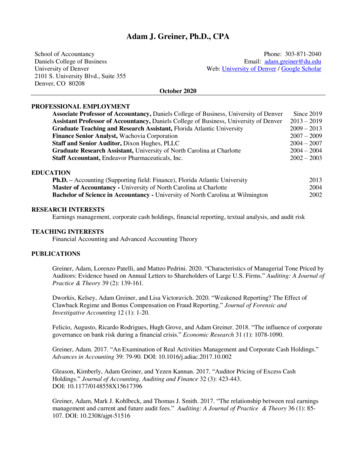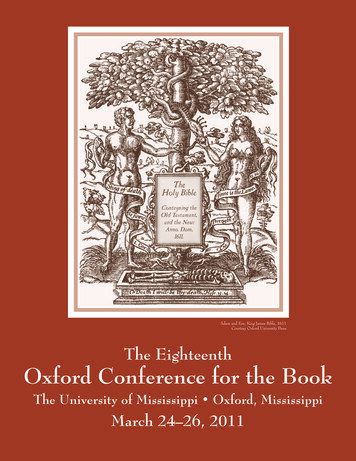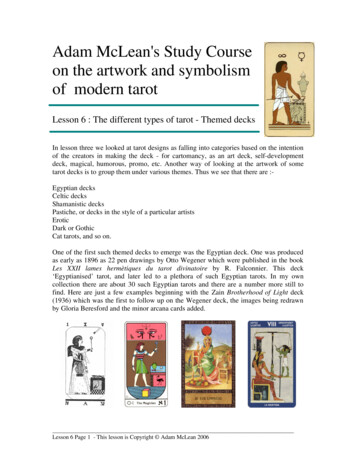
Transcription
Adam McLean's Study Courseon the artwork and symbolismof modern tarotLesson 6 : The different types of tarot - Themed decksIn lesson three we looked at tarot designs as falling into categories based on the intentionof the creators in making the deck - for cartomancy, as an art deck, self-developmentdeck, magical, humorous, promo, etc. Another way of looking at the artwork of sometarot decks is to group them under various themes. Thus we see that there are :Egyptian decksCeltic decksShamanistic decksPastiche, or decks in the style of a particular artistsEroticDark or GothicCat tarots, and so on.One of the first such themed decks to emerge was the Egyptian deck. One was producedas early as 1896 as 22 pen drawings by Otto Wegener which were published in the bookLes XXII lames hermètiques du tarot divinatoire by R. Falconnier. This deck‘Egyptianised’ tarot, and later led to a plethora of such Egyptian tarots. In my owncollection there are about 30 such Egyptian tarots and there are a number more still tofind. Here are just a few examples beginning with the Zain Brotherhood of Light deck(1936) which was the first to follow up on the Wegener deck, the images being redrawnby Gloria Beresford and the minor arcana cards added.Lesson 6 Page 1 - This lesson is Copyright Adam McLean 2006
Next we have another influential tarot, the Egypcios Kier produced in 1970 in Argentina.A number of tarots, especially in South America, derive from this. In the last few decadessome very fine workings of Egyptian imagery into tarots were created, such as the CliveBarrett Ancient Egyptian Tarot shown third above. The final item is the Tarot of theSphinx by Silvana Alasia, 2000, copying the style of the images on the walls of Egyptiantombs. We will devote a complete lesson to the diversities of Egyptian tarots later in thiscourse.In the 1980’s there arose the construction of a ‘celtic’ esotericism, based on some earlyWelsh and Irish mythological texts intermixed with Holy Grail esoterics. A rush of booksappeared to popularise this newly devised Celtic esoteric philosophy, and the tarotcreators were not far behind these publications. These primarily arose out of Britishoccultists, such as Dion Fortune, Gareth Knight, John and Caitlin Matthews, BobStewart, among others. Their books, written in the 1970’s and 80’s, were extremelyinfluential in constructing this stream of ‘Celtic’ esotericism, and this quickly shaped thedevelopment of some tarot decks. We will find, confusingly, a number of different tarotdesigns each called the ‘Celtic Tarot’, then we have Celtic Wisdom, Celtic Dragon,Arthurian, Avalon, Merlin, Greenwood, Tarot of the Druids and so on. There were a fewearly unpublished tarots which explored the Celtic theme, but the main group of Celtictarot decks appears from about 1990. Bob Stewart’s Merlin Tarot, was among the first,being issued in 1988. The deliciously soft and yet detailed artwork for this deck was byMiranda Gray. Bob Stewart restructures the deck to reflect his understanding of theMerlin myths. The major arcana are renumbered and the suits are Serpents, Birds, Fishesand Beasts, mirroring the four elements. A few years later Miranda Gray was again calledon by the same UK publisher, Aquarian Press, to produce designs for a Celtic tarot, theArthurian Tarot of Caitlin and John Matthews. Her wonderful paintings are here evenmore sharply drawn.Some of these Celtic tarots are rather solemn, severe and self-absorbed, such as Legend:The Arthurian Tarot of Anne-Marie Ferguson of 2003 or the Celtic Tarot of Julian deBurgh issued in 2000, but this was countered by the Italian Celtic tarots issued by LoScarabeo which are more irreverent and humorous. Here we see the Tarocchi dei Celti1991 by Benito Jacovitti the Italian comic artist who died in 1997, and the Laura Tuan ITarocchi Celtici of 1997. Lo Scarabeo has published at least five Celtic themed tarotdecks.Lesson 6 Page 2 - This lesson is Copyright Adam McLean 2006
Paralleling the development in the 1970’s and 1980’s of a ‘Celtic esotericism’, we alsosaw the emergence of interest in a reconstructed esoteric shamanism. This was perhapspartly inspired by the ‘factional’ books of Carlos Castaneda, who presented shamanisticpractices in a way that was approachable by the twentieth century mind. A rash of booksappeared in which the authors trawled through anthropological research and repackagedthis for the emerging esoteric audience, and the somewhat crude superstitious practices oftribal peoples, became elevated to deep spirituality. This impacted on and was reflectedin tarot. Tarot artists seem always close to interesting new ideas and quickly soak up anemerging perspective and give it a tarot form. So shamanistic themed decks began toappear. Many of these drew on the perceived imagery of North American indigenoustribes, though seen perhaps through a veil of romanticism. Thus we have the NativeAmerican of 1982, Medicine Woman 1990, Santa Fe 1994, Tarot of the Southwest SacredTribes 1996, the Vision Quest Tarot produced in 1998, which rapidly expanded to includeother indigenous cultures such as that of the Australian Aborigines celebrated in theAustralian Contemporary Dreamtime Tarot of 1991 and early stone age culture in theRock Art Tarot of 1996.There developed among some tarot creators from the 1980 onward a wish to create adeck in the style of some well known artist. We could pejoratively label this as pastiche,but it is often a more positive wish to honour or reflect in some way a well loved artistthrough the medium of a creating a tarot in their style. Among the earliest of these mustbe Wolfgang Poggi I Tarocchi di Dante e dei Fedeli d’Amore which was printed in Milanin 1983. These large cards are in the style of 15th Century Italian painting. As a conceitthe artist has signed the Magician card “Anonimo Bolognese del XX sec” - indicatingthat this is by an unknown artist of Bologna during the 20th century.The Italian mass market tarot publisher Lo Scarabeo has commissioned a number of thistype of deck, such as their Giotto Tarot of 2001 painted by Guido Zibordi in style similarto Poggi’s ‘Dante’ of some 18 years earlier. In 2003 they issued the Breugel Tarot byGuido Marchesi. Atanas Atanassov, a Bulgarian artist, is perhaps the real master of thisform and he has made a number of these tarots for Lo Scarabeo, the Bosch Tarot of2000, the Leonardo da Vinci of 2003, the Golden Tarot of Klimt, and a few others. TheBosch Tarot is so well constructed. This is no ‘cut and paste’ collage, but a repainting ofthe imagery into a tarot context. Those who know well Hieronymous Bosch’s paintingswill recognise the scenes on which Atanassov has drawn. He simplifies the artwork aLesson 6 Page 3 - This lesson is Copyright Adam McLean 2006
little and focuses it into serving the purpose of directly reflecting tarot imagery.It is not just high art that can be used as a stylistic model for a tarot deck. We find forexample the wonderfully humorous conception of the Housewives Tarot of 2004 which isin the style of 1950’s American consumer advertising and packaging imagery. This iseven provided in a box imitating the way in which people collected recipes on cards backin the 1950’s and 60’s.Playing cards with erotic designs have been produced for many years so it is notsurprising perhaps that this theme appeared in a number of tarot decks. Of course, someof the individual tarot arcana have lent themselves to an erotic interpretation, the Loversand the Devil being the two obvious examples, but some tarot artists went the full wayand placed all the cards into a erotic context. Tarot Druuna (1998), being a jeu de tarot,or French deck used for playing the card game, is perhaps closest to the conception ofplaying cards with erotic designs. It is based on the main character Druuna in a series ofscience fiction comic book stories the Morbus Gravis by Paolo Eluteri Serpieri. Sheseems to be merely a vehicle for Serpieri’s rather adolescent fixations, and the TarotDruuna will not disappoint that readership (or perhaps “viewership”). The Americanartist Lori Walls has created a Tarot Erotica with amazingly detailed paintings. Shebrings an erotic component to each of the cards, some of which have rather disturbingimagery, however this is not the adolescent view of Serpieri but a more matureconception. We should not fail to mention the infamous erotic tarot by Amerigo Folchi.Folchi’s work has often had an erotic charge to some of the cards, but in 1991 he musthave almost exhausted himself creating his Tarocco Erotico dei Giardini di Priapo, his“erotic tarot of the garden of penises”. Priapus is the Greek male God of fertility usuallydepicted with an erect phallus. Folchi’s work here, though totally explicit, is in a cartoonstyle and full of humour, and this tarot deck should not offend too many people. The mostrecent erotic deck I have seen is the Astar or Astaroth Tarot from Russia issued in 2006.This is a collage deck, most of the cards of which have an erotic content. Astaroth is thename of a demon in western magic, who tried to seduce souls into hell through offeringthem worldly delights. There are a number of other erotic decks whose approach to thesubject is unique and distinctive, so we will devote a lesson later in this course tosurveying the variety of erotic decks. Many of the erotic tarots seem to depict the Toweras an erect penis!Lesson 6 Page 4 - This lesson is Copyright Adam McLean 2006
Here are the Tower cards from the Folchi, the Swedish Ylva Trollstierna Erotica Tarot,the Esteban Lopez and the Lori Walls.There are many themes one finds explored by tarot artists. We will look at cats and gothicthemed decks in some detail shortly and the next lesson will show a small group of deckson a rather specialist theme.Lesson 6 Page 5 - This lesson is Copyright Adam McLean 2006
recent erotic deck I have seen is the Astar or Astaroth Tarot from Russia issued in 2006. This is a collage deck, most of the cards of which have an erotic content. Astaroth is the name of a demon in western magic, who tried to seduce souls into hell through offering them worldly delights. There are a number of other erotic decks whose approach .



